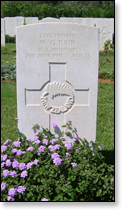The Project
-
To photograph all the war graves and primary memorials of New Zealanders who, serving with New Zealand and Allied forces, died in conflicts, from the Anglo-Boer war (1899-1902), to the present day and in peacekeeping operations. Our research has identified 31,758 New Zealand war graves in 79 countries including New Zealanders serving with other Allied forces.
-
To produce a photographic record of the relevant major cemeteries and surrounding areas.
-
To create a digital archive and database, accessed via a website, enabling free public access to their biographical information and images.
-
To instigate community and education programmes based around the project.
-
To instigate the making of a TV documentary telling the story of the project, the cemeteries, but most of all the servicemen.
-
To co-operate and collaborate with others working in similar areas, to ensure accuracy and compatibility of data.
Overview
There are 31,758 New Zealanders whom the New Zealand War Graves Trust project has been able to identify to date who, serving with New Zealand and Allied forces, died in conflicts from the Anglo-Boer War (1899-1902) up to the present day and in peacekeeping operations. They are commemorated by burial in Commonwealth War Grave cemeteries, public cemeteries, graves in New Zealand or by inscription on memorials world wide.
The Commonwealth War Graves Commission, funded by all Commonwealth governments, administers the cemeteries and memorials. Administration in New Zealand is charged to the Ministry for Culture and Heritage. The Commission has developed an excellent website, containing a database of servicemen and some pictures of the cemeteries in their care. The Ministry for Culture and Heritage has an informative site, giving some detail of their operation in this area.
Our project builds on this information by developing an exhaustive high-resolution photo-archive of all cemeteries, headstones and memorials of New Zealand servicemen, who died in conflict.
Our internet site is the obvious and logical way for the public to access the archive at present, but a parallel main purpose of the project is to collect the images and associated information in such a way as to form an historical text for future use.
Locations
While the largest numbers of casualties are located in the areas of the major battles and campaigns (Gallipoli, Greece, North Africa, Western Front, Italy…), New Zealand forces have served in most of the major conflicts of the 20th Century and their graves and memorials are spread across most of the world.
Amongst these are “oddities” such as the single graves in the Faroe Islands, Falklands and Azores, the servicemen interred in the USA, Iceland and Bangladesh and those graves scattered throughout the African continent. These are of interest in New Zealand’s military history and illustrate the diverse theatres of war, numerous for a small country, where New Zealanders served.
In New Zealand there are the graves and memorials of 3,484 New Zealanders in service that perished both at home and overseas. Some are buried in the 127 servicemen’s cemeteries, others in local churchyards. Many are commemorated only on memorials, as their remains were lost.
The United Kingdom in our most recent estimation is the last resting place of 2,110 New Zealanders serving overseas.
The scope of the project extends the numbers contained in the Commonwealth War Graves Commission database (until recently focused on World War I and World War II), to include those that died subsequent to their World War II cutoff of 1st December 1947 (Jayforce, Korea, Malaya, Vietnam etc). Numbers of war dead contained in this proposal are from the Commonwealth War Graves Commission and the New Zealand Ministry for Culture and Heritage.
How it began

The idea for this project came about by chance. For every Anzac Day as long as I can remember my family had always remembered the World War II loss of my mother’s first husband, Ian Gough, in Egypt, and the loss of her brother, Bill Bain, in Crete.
A few years ago, when my mother fell ill and was admitted to hospital, I visited Joyce, an old friend of her’s to let her know what was happening to Mum. Although they were too old to visit each other on a regular basis they kept in touch by phone. Joyce was my Uncle Bill’s fiancée and, although she had happily married later, she told me she thought of him every day and all she really wanted was a picture of his grave.
 Time passed and Joyce moved out of Auckland, but it nagged me that I hadn’t managed to get a picture of Bill’s grave for her. It wasn’t until a friend visited Crete, that I managed, with her help, to fulfil my promise. She was able to see a picture of Bill’s grave in the Suda Bay cemetery.
Time passed and Joyce moved out of Auckland, but it nagged me that I hadn’t managed to get a picture of Bill’s grave for her. It wasn’t until a friend visited Crete, that I managed, with her help, to fulfil my promise. She was able to see a picture of Bill’s grave in the Suda Bay cemetery.
In thinking about how to obtain the photograph, I wondered if other people ended up in a similar position, and from there I developed the idea of virtual war cemeteries and a digital roll of honour.

Although the Commonwealth War Graves Commission has a good website (www.cwgc.org/), it is not what we had in mind as a lasting on-line memorial to New Zealand’s war dead.
The Auckland War Memorial Museum has developed a comprehensive on-line database, Cenotaph, and they have agreed that material gathered in this project will complement their site.
Dennis Kerins
Photographs
Left: Bill Bain's grave in Suda Bay cemetery.
Right: Ian Gough (above) and Bill Bain.
